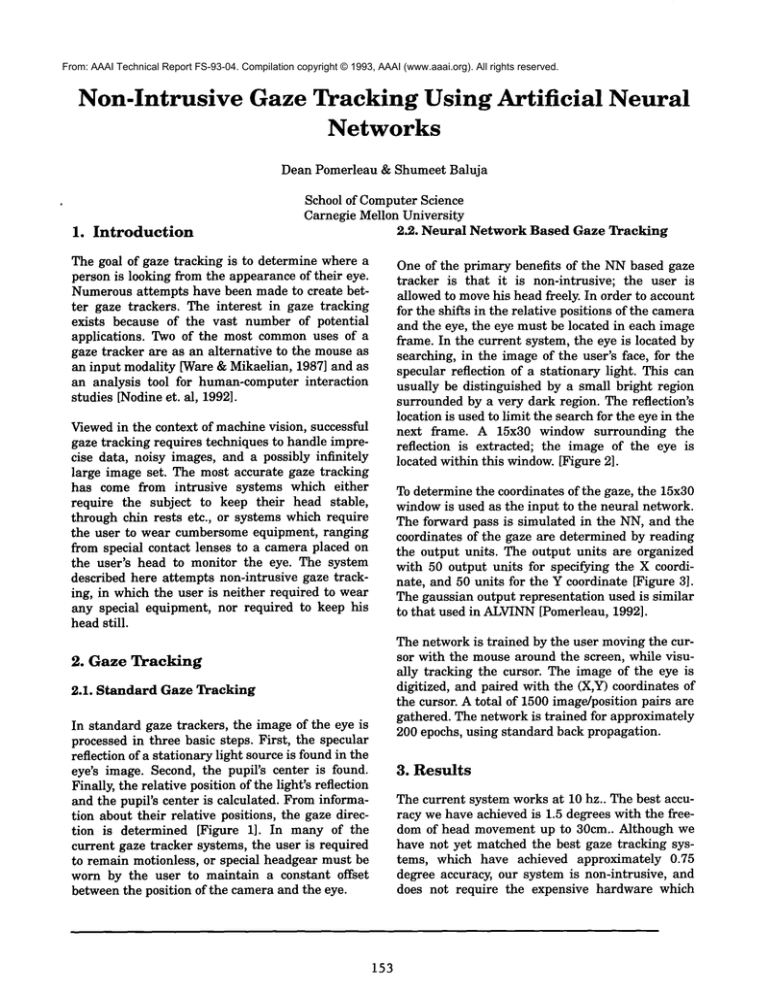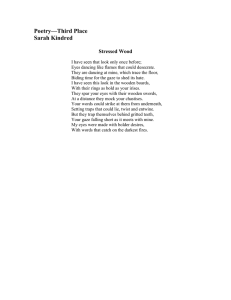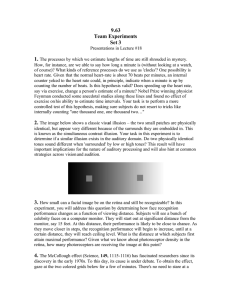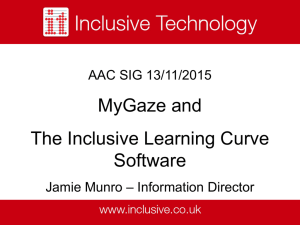
From: AAAI Technical Report FS-93-04. Compilation copyright © 1993, AAAI (www.aaai.org). All rights reserved.
Non-Intrusive
Gaze Tracking Using Artificial
Networks
Neural
Dean Pomerleau & Shumeet Baluja
1. Introduction
School of ComputerScience
Carnegie Mellon University
2.2. Neural Network Based Gaze Tracking
The goal of gaze tracking is to determine where a
person is looking from the appearance of their eye.
Numerousattempts have been made to create better gaze trackers. The interest in gaze tracking
exists because of the vast number of potential
applications.
Twoof the most commonuses of a
gaze tracker are as an alternative to the mouseas
an input modality [Ware & Mikaelian, 1987] and as
an analysis tool for human-computer interaction
studies [Nodineet. al, 1992].
One of the primary benefits of the NNbased gaze
tracker is that it is non-intrusive; the user is
allowed to movehis head freely. In order to account
for the shifts in the relative positions of the camera
and the eye, the eye must be located in each image
frame. In the current system, the eye is located by
searching, in the image of the user’s face, for the
specular reflection of a stationary light. This can
usually be distinguished by a small bright region
surrounded by a very dark region. The reflection’s
location is used to limit the search for the eye in the
next frame. A 15x30 window surrounding the
reflection is extracted; the image of the eye is
located within this window.[Figure 2].
Viewedin the context of machinevision, successful
gaze tracking requires techniques to handle imprecise data, noisy images, and a possibly infinitely
large image set. The most accurate gaze tracking
has come from intrusive systems which either
require the subject to keep their head stable,
through chin rests etc., or systems which require
the user to wear cumbersome equipment, ranging
from special contact lenses to a camera placed on
the user’s head to monitor the eye. The system
described here attempts non-intrusive gaze tracking, in which the user is neither required to wear
any special equipment, nor required to keep his
headstill.
2.
To determine the coordinates of the gaze, the 15x30
windowis used as the input to the neural network.
The forward pass is simulated in the NN, and the
coordinates of the gaze are determined by reading
the output units. The output units are organized
with 50 output units for specifying the X coordinate, and 50 units for the Y coordinate [Figure 3].
The gaussian output representation used is similar
to that used in ALVINN
[Pomerleau, 1992].
The network is trained by the user movingthe cursor with the mousearound the screen, while visually tracking the cursor. The image of the eye is
digitized, and paired with the (X,Y) coordinates
the cursor. A total of 1500 image/position pairs are
gathered. The network is trained for approximately
200 epochs, using standard back propagation.
Gaze Tracking
2.1. Standard Gaze Tracking
In standard gaze trackers, the image of the eye is
processed in three basic steps. First, the specular
reflection of a stationary light source is found in the
eye’s image. Second, the pupil’s center is found.
Finally, the relative position of the light’s reflection
and the pupil’s center is calculated. Frominformation about their relative positions, the gaze direction is determined [Figure 1]. In many of the
current gaze tracker systems, the user is required
to remain motionless, or special headgear must be
worn by the user to maintain a constant offset
between the position of the cameraand the eye.
3. Results
The current system works at 10 hz.. The best accuracy we have achieved is 1.5 degrees with the freedom of head movement up to 30cm.. Although we
have not yet matched the best gaze tracking systems, which have achieved approximately 0.75
degree accuracy, our system is non-intrusive, and
does not require the expensive hardware which
153
many other systems require. Figure 4 shows how
our system compares with a commercial gazetracking system, the ISCAN.
as a tool for data collection
interaction experiments.
in human-computer
References
4. Future
Directions
Oneof the largest problemsin existing eye trackers
is the inability to handle user motion. To address
the problem of user motion, a mobile camera could
be used. To control the camera, another neural network can be trained to keep the user’s face in the
center of the image. An extension of this idea is to
use a neural network to find the eye in the image of
the face. Currently, the heuristic used to find the
eye in the imageof the face is to locate a bright spot
surrounded by dark regions. However, neural networks have been applied to facial feature tracking
[Hutchinson, 1990] [Debenham, 1991] and this
technology mayhelp here. Another extension of the
idea of facial tracking is using extra inputs units to
represent the head position. Finally, for increased
accuracy, a higher resolution image of the eye may
yield improved results. The current resolution is
only 15x30 gray-scale pixels. Increasing the resolution may, however, decrease the speed of the gaze
tracker.
In order to rapidly train the neural network to new
users, one method may be to use a multiple network architecture,
as was used in the MANIAC
autonomousroad following system [Jochem, 1993].
In this system, several smaller "expert" networks
were trained on different road types, ie. one lane,
two lane etc.. An arbitrating
network, which
resided "on top" of the smaller networks, is used to
select which of the expert networks is yielding the
best response to the current road. In a similar manner, expert networks can be trained on several different people, with retraining only having to
change the weights in the arbitrating network.
Arbitration between networks could also be constructed through the use of metrics which estimate
the output reliability [Pomerleau, 1993]. A benefit
of the expert network approach is that each of the
expert networks can be trained independently of
the 6thers.
This flexibility of head position makesthe connectionist gaze tracker muchless intrusive than existing systems. Wewould like to test the viability of
replacing the mouse with the connectionist gaze
tracker. Other potential uses for the system, which
wewill be tested in the future, include helping disabled people interact with their environment, and
154
Hutchinson, R.A. (1990), "Development of an MLP
feature location technique using preprocessed
images". In proceedings of International Neural Networks Conference, 1990. Kluwer.
Jochem, T.M., D.A. Pomerleau, C.E. Thorpe (1993),
"MANIAC:A Next Generation Neurally Based
AutonomousRoad Follower". In Proc. of International Conference on Intelligent AutonomousSystems (IAS-3).
Debenham, R.M. & S.C.J. Garth (1991), "The
Detection of Eyes Using Radial Basis Functions".
In Proceedingsof the 1991International Conference of
Artificial Neural Networks ICANN-P]. Amsterdam,
Netherlands, North-Holland.
Fahlman, S.E. & Lebiere, C. (1991) "The Cascade
Correlation Learning Architecture". Advances in
Neural Information Processing Systems 2. D.S.
Touretzky (ed.) MorganKaufmann,pp. 524-532.
Nodine, C.F., H.L. Kundel, L.C. Tote & E.A.
Krupinksi (1992) "Recording and analyzing eyeposition data using a microcomputer workstation",
Behavior Research Methods, Instruments & Computers 24 (3) 475-584.
Pomerleau,D.A. (1991) "Efficient Training of Artificial Neural Networks for AutonomousNavigation,"
Neural Computation3:1, Terrence Sejnowski(Ed).
Pomerleau, D.A. (1992)Neural NetworkPerception for
Mobile Robot Guidance. Ph.D. Thesis, Carnegie Mellon University. CMU-CS-92-115.
Pomerleau, D.A. (1993) "Input Reconstruction Reliability Estimation", Neural Information Processing
Systems 5. Hanson, Cowan, Giles (eds.) Morgan
Kaufmann, pp. 270-286.
Starker, I. & R. Bolt "A Gaze-ResponsiveSelf Disclosing Display", In CHI-90. Addison Weseley, Seattle, Washington.
Ware, C. & Mikaelian, H. (1987) "An Evaluation
an Eye Tracker as a Device for ComputerInput", In
J. Carrol and P. Tanner (ed.) HumanFactors in
ComputingSystems - IV. Elsevier.
Figures
Specular
Reflection
Looking
Light
at
Looking
Above
Light
Figure 1. Relative
position
Looking
Below
Light
of specular
Figure 2. The 15x30 window extracted
user’s face.
155
reflection
Looking
Left
Light
and pupil.
from the image of the
of
O OO
50 X output
Units
000
50 Y output
Units
4 Hidden
Units
iiiiiiiiiii!iiiiiiiiiiii!iiiiiiiiiii~iiii~:i
15x30
Input
Retina
Figure 3. Network Architecture
Projected
ISC;~f
50
ISCAN~
NNGaze~ker
100
1.50
200
250
CameraField of View(ram)
Figure 4. NNgaze tracker
156
vs. ISCAN.
300





